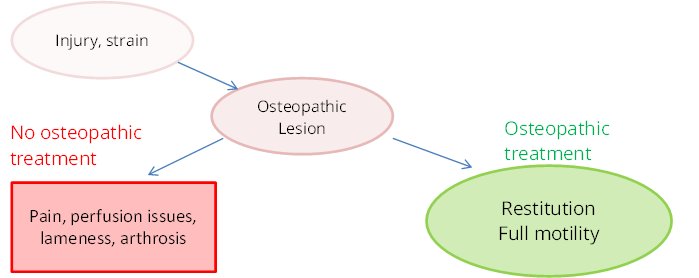Osteopathy is a manual therapy. A therapist recognizes restrictions in joint movement in range and quality, that will probably lead to evasive movement and later on to pain, inflammation.and lameness. Advantages of osteopathy are, you can treat minimal changes in movement patterns, that are not yet lamenesses and don’t already cause structural damage. It means, that change is so insignificant, a good rider is still able to “ride over” it. You won’t even realize them, maybe an obstructiveness, a clock error or a small problem with a certain lection.
But is it all right to “ride over” it and disregard it as harmless?
Probably not. Because to still exercise a certain movement, the horse has to change its pattern and overexerts structures, that are not made for the resulting higher pressure.
Let me give you an example: Os carpi accessorius (pisiform). Small bone, big problems.
The os carpi accessorius is tied to the ellbow over a short muscle cord and reaches to structures below like the tendon sheath of the flexor tendons, the suspensor apparatus and the sesamoides and their ligaments. While flexing it glides to the inside of the joint and prevents the joint of overflection and the ellbow of getting hit by the hoof. It’s also a cover for the flexor tendons. More important the function in extension. In this phase the pisiform glides to the outside, wich opens up the carpal tunnel. This enables the flexor tendons to full extension.
Is the outward movent of the pisiform only happening in partial, the pressure in the carpal tunnel inhibits the blood circulation (A. mediana) and the nervous system (N. medianus). This is a possible influence for circulatory problems in the middle part of the deep flexor tendon (wich is not nourished by the tendon sheats) and probably the navicular bone and the coffin bone.
Ruptures of the deep flexor tendon or its supporting ligament and changes in the bone structure of the navicular bone may come up.
What you can often see, even on the standing horse is the flexion of the pastern joint. The flexion of the coffin joint may be visible in an x-ray. This flexion leads to overextension of the dorsal parts of the pastern and the coffin joint, in later chronicle stages visible as an ringbone.
The flexion of the digital joints also leads to more pressure to the frontal part of the coffin bone and to circulatory disturbances, hypersensibility of the hoof and – worst case – laminitis.
There is no other diagnostic possibility as the examinition by an osteotheapist.
That’s why it makes sence to see osteopathy not only as a means to correct manifest movement disorders or lamenesses, but see it as a regular prophylactic treatment. Bevor you feel there is something wrong. Bevor the horse is lame. Because the horse as a flight animal is depending on its speed and movability. It is gonna try as long as possible to hold up the appearence of health. Even if that means to change the movement pattern to the worse.
But there is not only a bodily change. Horses with blockades, that are restricted in their ability to react fast and move fluid, will change in mind. They get spooky, tense and maybe even aggressive. A behavior problem may sometimes be a physical problem.
